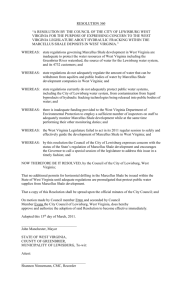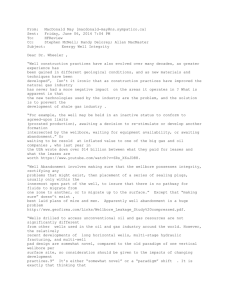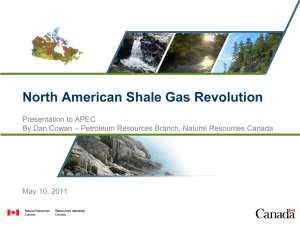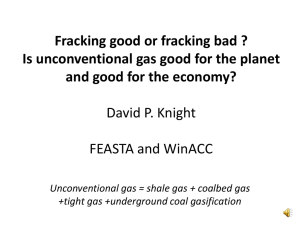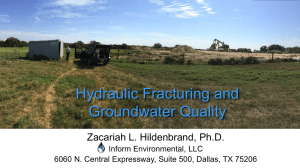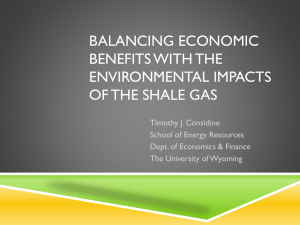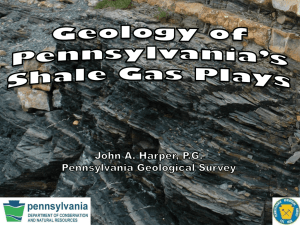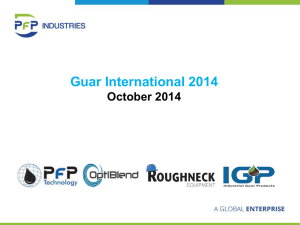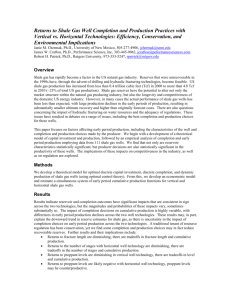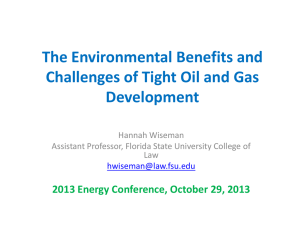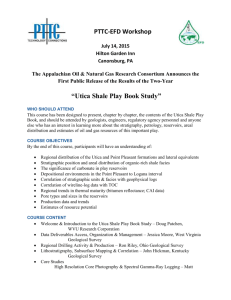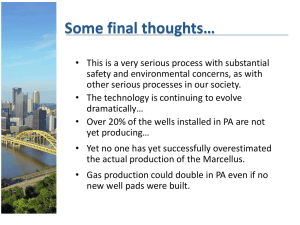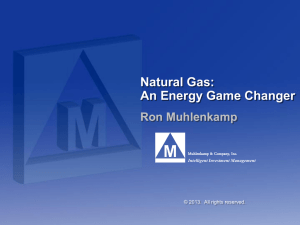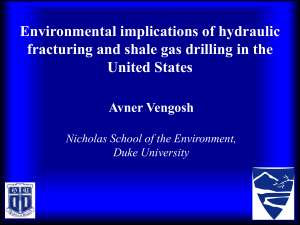West Virginia Production
advertisement
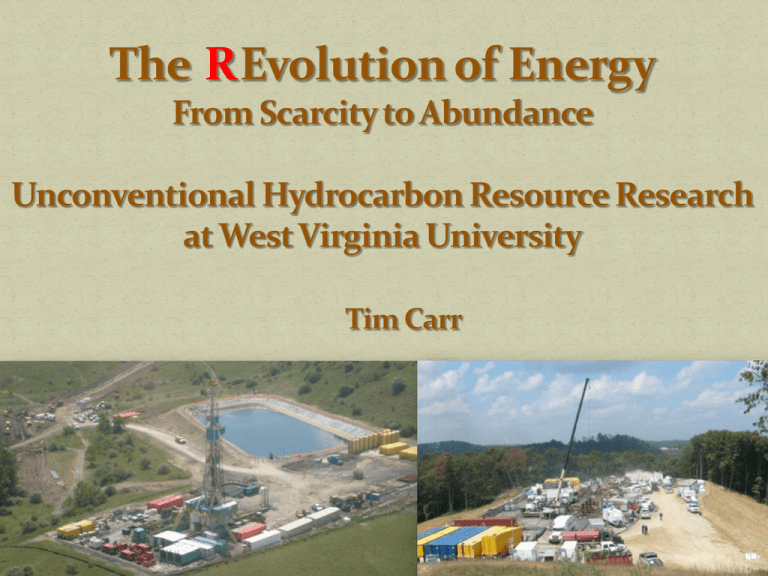
R Slide 2 US Surpasses Russia as the World’s Largest Energy Producer (Liquids and Natural Gas) Geopolitical Upheaval Infrastructure Upheaval Appalachian Basin Gas Production 2008 - 2.3% of US Production 2012 - 11% of US Production 2020 - 30% of US Production – Northeast Self Sufficient? Natural Gas Price NYMEX Crude Oil – Natural Gas Ratio, historical Norm 7.5X before 2007 2008 54X, Now Averaging 30X Henry Hub Spot $3.73 MMBtu (10/11/2013) Marcellus NE PA $1.94 MMBtu (10/11/2013) Impact on Consumers and Energy Slide 3 Multiple Research Areas (Applied and Basic) Subsurface Efficiency Geographic Information Systems Subsurface Imaging Geocellular Modeling (Static and Dynamic) Microbial Diversity Surface Impacts Drilling Fluids Land Use Water Protection Utilization Societal/Policy Overseas – Poland, Jordan, China Education Higher Education/Professional Education Public Outreach Land Grant Mission Slide 4 Deep Shale Microbial Biodiversity (NSF) Paula Moser OSU – Shikha Sharma Geographic Information Systems Land Use -Shawn Grushecky Geologic – Petroleum Engineering Modeling Geophysical Imaging Drilling Fluids Ilkin Belgesu WVU – Jeff Daniels Societal/Policy/Overseas MOU Polish Technical Universities – Robert Blobaum Shale Energy and Environment Laboratory (SEEL) Transparent Utica and Marcellus Wells WVU Research VP Fred King Primary Representative - Tim Carr Communications - Trina Wafle WVU Steering Committee Utilization Brian Anderson Environmental Subsurface Kashy Aminian Societal Impacts/Policy James VanNostrand Paul Ziemkiewicz Education Sue DayPerroots Outreach Steve Bonanno OSU Research VP Caroline Whitacre Primary Representative – Jeff Daniels Communications - Gina Langen WVUSteering SteeringCommittee Committee OSU Utilization Subsurface Dave Cole Jim Durand Societal Impacts/Policy Douglas Southgate Environmental Richard Moore Education Outreach Ken Martin Ken Martin Slide 7 http://www.unconventionalenergyresources.com/ Slide 8 Utica Marcellus http://www.unconventionalenergyresources.com/ Slide 9 West Virginia Annual Gas Production Billion Cubic Feet 900 800 Unconventional (Shale) 700 Conventional 600 500 2013 gas production is estimated from Bentek pipeline report for West Virginia. West Virginia gas production averaged 2.34 Bcf/d through mid July 2013 (51% increase from same period of 2012). 74% 400 300 200 100 0 2007 2008 2009 2010 Year 2011 2012 2013 Slide 10 West Virginia Producing Gas Locations 60,000 50,000 0.4% Unconventional (Shale) Producing Pads Conventional 40,000 West Virginia Marcellus Horizontal Wells Reporting Production 30,000 Year 2007 2008 2009 2010 2011 2012 20,000 Wells 2 11 59 164 357 640 Pads 2 10 40 93 162 223 Wells/Pad 1.0 1.1 1.5 1.8 2.2 2.9 10,000 0 2007 2008 2009 2010 Year 2011 2012 Slide 11 West Virginia Annual Liquids Production 3,000 Unconventional Shale Thousands Barrels 2,500 Conventional 2,000 37% 1,500 1,000 500 0 2007 2008 2009 2010 Year 2011 2012 Slide 12 West Virginia Producing Liquids Wells 12,000 10,000 Producing Wells 2% 8,000 Unconventional (Shale) Conventional 6,000 4,000 2,000 0 2007 2008 2009 2010 Year 2011 2012 Slide 13 Northern Appalachian Annual Gas Production 3,000 2,500 Billion Cubic Feet Northern Appalachian Basin Defined as Ohio, Pennsylvania and West Virginia 2,000 1,500 Unconventional (Shale) Conventional 82% 1,000 500 0 2007 2008 2009 2010 Year 2011 2012 Slide 14 Northern Appalachian Annual Liquids Production 12,000 Northern Appalachian Basin Defined as Ohio, Pennsylvania and West Virginia 29% Thousands Barrels 10,000 8,000 Unconventional Shale 6,000 Conventional 4,000 2,000 0 2007 2008 2009 2010 Year 2011 2012 Slide 15 8,440 Horizontal Wells & Locations 200 Km Slide 16 Shawn Grusheky and WV GIS Tech Center Slide 17 Microbial Community Dynamics Metabolic Activities and Trophic Network Paula Mouser and Shikha Sharma Slide 18 Wang and Carr, 2012 Slide 19 Wang and Carr, in press Slide 20 Faults from Arcadian Orogeny Slide 21 J1 A1 J1 Each square 500 x 500 feet Microseismic, Inc. Slide 22 New Faculty Hires Downstream Utilization Production of Fuels and Chemicals Combustion in stationary Sources Mobile Vehicle Systems Enhanced Applications – Fuel Cells, Waste Heat Utilization Energy Policy and Economic Development Regulatory Aspects Regional Analysis Sustainability Shale Energy and Environment Laboratory (SEEL) Ohio State University-West Virginia University Transparent Utica and Marcellus Wells Slide 23 Tim Carr Phone: 304.293.9660 Email: tim.carr@mail.wvu.edu

